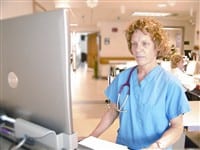Keys To The Future Of Medicine Baystate CIS System Puts Information At One’s Fingertips
Tina Frazier laughed when she said that she no longer has to worry about trying to read physicians’ notoriously bad handwriting.
But legibility is a serious matter when it comes to safety in delivery of health care, and that’s just one of the many issues addressed through implementation of a new clinical information system, or CIS, at Mary Lane Hospital in Ware. Frazier, nurse manager of the Davis Wing, the med-surg unit at the hospital, said the benefits from CIS, or computerized physician order entry (CPOE), as it’s known, come in the form of enhanced patient safety, more efficient communication among caregivers, and vastly improved data collection and research.
“This puts information at your fingertips,” said Frazier, gesturing toward a mobile workstation known affectionately as a PAL — mostly because it provides what is called a ‘patient access list’ — that is part of a system that has taken the hospital to the cutting edge of electronic medical record-keeping, or EMR.
The workstations enable doctors and nurses to read and enter information about a patient at the point of care, saving time and potentially eliminating medical errors in the process. The system is considered the next generation of electronic medical record technology, and comes complete with drug-allergy alerts, drug-dosage monitoring, drug-drug interaction alerts, and other features.
The Mary Lane CIS-implementation project, completed in mid-October, is part of a broader, $25 million initiative undertaken by Baystate Health System (BHS) that includes its three member hospitals, Mary Lane, Franklin Medical Center (FMC), and Baystate Medical Center, as well as physician practices and VNA. The advanced CIS system was put in place at FMC in late November, and will go online at Baystate in January.
Rick Gerstein, M.D., medical director at Mary Lane, said that going online at the 31-bed hospital and thus creating a CPOE system has entailed a serious learning curve, especially for physicians not fluid in the use of a computer. But it has yielded a new way of doing things that is in many ways quicker — and all ways safer — than the system previously in use.
“There are risks in hand-writing medications even if someone has perfect handwriting,” said Gerstein, noting that CPOE eliminates or mitigates many issues involving legibility and interpretation of hand-written and phoned-in orders. “That’s just one of the ways this new system has given us a new, safer way of providing care.”
BHS is becoming a national leader in the implementation of electronic medical record, or EMR, said Joan Sullivan, vice president of Clinical Informatics and Re-Engineering at Baystate and point person for the system’s three-year-long venture to integrate the technology. She noted that only 12{06cf2b9696b159f874511d23dbc893eb1ac83014175ed30550cfff22781411e5} of hospitals nationwide have some form of electronic records, and only 3.5{06cf2b9696b159f874511d23dbc893eb1ac83014175ed30550cfff22781411e5} of the nation’s hospitals have a system as advanced as the one being implemented by BHS.
| “There are risks in hand-writing medications even if someone has perfect handwriting. This system has given us a safer way of providing care.” |
Electronic Medical Record is being pushed by both national and state leaders, said Sullivan, and President Bush has made it a goal to have all hospitals implement EMR within 10 years. BHS is well ahead of that pace, she said, because it recognizes that, while there is a significant cost attached to the program, overall patient care is improved, and the number of errors made in the course of delivering that care is reduced — saving the system money in the long run.
Screen Test
Baystate is partnering with Missouri-based Cerner Corporation, one of the leading makers of CPOE technology, in implementation of its new system, an initiative that will eventually involve the installation of 300 mobile devices — 241 at Baystate Medical Center, 44 at FMC, and 15 at Mary Lane — as well as more-permanent sites.
Conversion to the new CPOE technology within the Baystate system has involved varying levels of transition, said Beverly Siano, MS, RN, CNAA, director of Clinical Information Systems and Patient Care Services for Baystate Health System. At Baystate and FMC, she noted, the process has entailed switching to newer technology with more horsepower and capabilites. At Mary Lane, however, implementation meant a more radical change — from an entirely paper-based medical record system to one that is fully computerized.
“This was a culture change for Mary Lane,” said Sullivan. “The entire work process has changed.”
Gerstein said the transition has been a two-year-long process, one that involved extensive research of systems on the market and, more recently, rigorous training with Cerner representatives to ensure that doctors, nurses, and other staff members are comfortable with the new technology and understand all its capabilities.
The transition has been difficult for some, he said, noting that many physicians get into routines involving orders and how they are given, and are not generally enamored with change. Meanwhile, some had questions about security, and others were not what would be considered computer-savvy. Overall, however, the transition was fairly smooth.
“It’s not like going from a car to flying an airplane,” he explained. “Yes, you’re going from a using a pen to clicking on a keyboard, but you’re looking at something that looks like a patient’s chart — it’s all very intuitive.”
System-wide, the new CIS technology will bring more speed, accurancy, and convenience to the process of compiling, checking, and updating medical records, said Sullivan.
Here’s how it works:
Using the example of a patient, with a history of heart problems, who comes to a hospital’s emergency room, Sullivan said that CIS comes into play the moment that individual comes through the door. ER personnel can visit an electronic record — similar to a written chart, as Gerstein described — to review the patient’s medical history, as well as a rundown of current medications, allergies, and other pertinent information. If a physician tries to prescribe a medication that will react negatively with another drug, the computer will issue an alert. If that same physician prescribes too large a dose, the computer will issue a similar alert.
As the patient is treated, the information on that electronic chart is updated, and can be checked by nurses at the bedside and a physician at the hospital, the office, or even at home.
This added convenience saves time in a number of ways, said Gerstein, noting that with the paper system used at Mary Lane — and most other small community hospitals — doctors and nurses would have to search for records. Meanwhile, the ability to review records from the office or home can save physicians trips to the hospital and eliminate the need to dictate orders over the phone, a practice that can lead to errors.
“We’re extremely fortunate to have a system like this here,” said Gerstein. “Mary Lane is one of the smallest hospitals in the country to have such an advanced system, and it’s because we’re affiliated with Baystate that we have such an incredible opportunity.”
Clicks and Bricks
While BHS’s new CPOE technology represents a culture change at Mary Lane, it is also a significant upgrade over the equipment that has been in use at Baystate Medical Center for roughly the past decade.
Sullivan described the existing technology — known as PCIS (Patient Care Information System) as mostly a communications tool, one that enables doctors to enter orders electronically and for professionals in a number of health fields, from physical therapy to pharmacology, to more effectively communicate on a patient’s status and treatment.
The new system provides what Sullivan called clinical-decision-support tools, which are an important step in reducing errors.
“If there’s a duplicate medication being ordered, or if there’s a drug the patient’s currently on and the physician is ordering a new drug and there might be an interaction that could be dangerous, our current system doesn’t have the capability to alert the physician in real time that there’s a problem,” she said. “Our new system will have an alert that will pop up, alerting the physician to a potential drug-drug intreraction.”
Another example, said Siano, is allergies to certain medications. If a patient is allergic to something and a physician attempts to prescribe it, the CIS will alert the physician to that fact and suggest possible alternatives.
| “The fact that we can automate a lot of the information allows a nurse to spend more time with a patient.” |
Overall, the advanced CIS system will enable health care professionals to make decisions more quickly and with more data available to them.
“It’s exciting to go onto the floors and see the teams use CIS to deliver care,” said Siano. “It’s extraordinary how you can see clinical information on a mobile device at the point of care; a care team can see up-to-the-minute clinical information that will help them make what I think are more-efficient decisions.
“People can make decisions quickly, with the correct information, right at the bed-side,” she continued. “That’s an extraordinary step ahead — there are no delays in getting information.”
The new system also results in substantial time savings, especially at Mary Lane, which was using an entirely paper-based system only a few months ago, said Siano. “The fact that we can automate a lot of the information allows a nurse to spend more time with a patient and not have to spend as much time writing things down; she can enter information at the point of care, they can see it right away, and retrieve it immediately. They can see results, see new orders, and deliver care.”
Speed and convenience are important benefits, but safety is the biggest concern, said Gerstein, noting that the CPOE system, while not fool-proof, certainly reduces the possibility of error in the delivery of care.
For starters, it eliminates or reduces the need to give orders in writing or over the phone — two practices that are fraught with potential problems, he said. In addition to legibility issues, said Gerstein, many doctors have employed short-hand methods that are, by their nature, subject to misinterpretation.
Noting that the letters Q.D. are used to prescribe a medication to be taken once a day, and that QID is used to note that something is be taken four times a day, Gerstein said it’s easy to see how mistakes can be made.
The CPOE system reduces the chance of error by taking handwriting out of the equation, he said, adding that, because there isn’t much actual typing to be done, the potential for typographical errors is minimal.
Using the drug Lipitor as an example, he said a physician would not actually have to spell out that word. Instead, as letters were typed, the computer present a list of possible choices. By the time ‘L’, ‘i’, and ‘p’ had been typed, the system would have identified Lipitor as the probable choice, and the physician would simply click on a box.
As for phoning-in orders, Gerstein said there is room for misinterpretation using that technology as well. “Sometimes, people think they hear something, when the person is actually saying something else,” he said. “CPOE eliminates that problem, too.”
The Right Type
While Gerstein was qualifying the benefits of CPOE, others have attempted to quantify it.
The First Consulting Group, a California-based think tank, has issued a report indicating that while the one-time start-up costs for computer physician order entry at the 46 Bay State hospitals that don’t have the technology would total $210, those facilities could save $275 million annually through a reduction in medical errors.
Looking at those numbers, Gerstein and others believe that when it comes to CPOE, the handwriting is on the wall — not on physicians’ orders.




Comments are closed.